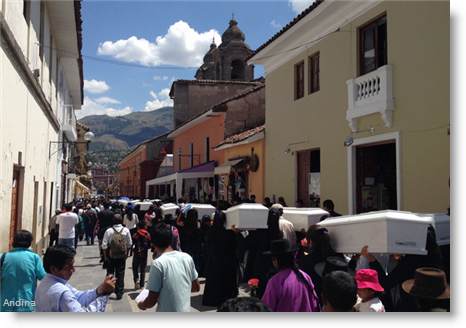 The remains of 80 people who were killed during Peru’s internal conflict with Shining Path rebels have been handed over to their families for burial, decades after their deaths.
The remains of 80 people who were killed during Peru’s internal conflict with Shining Path rebels have been handed over to their families for burial, decades after their deaths.
The ceremony, led by the Public Prosectuor’s Office, took place in Peru’s southern Andean region of Ayacucho, which was at the center of the bloody conflict in the 1980s and early 1990s.
The bodies of the victims were identified by forensic anthropologists, who exhumed mass graves between 2011 and 2013 in Ayacucho and used DNA to identify the individuals, daily El Comercio reported.
Of these 80 victims, 51 were killed by the Shining Path and 29 by the state security forces. The killings occurred between 1983 and 1992, and the victims included adult men and women, two of whom were pregnant, as well as children.
The unmarked mass graves were uncovered in Huamanga, Huanta, Cangallo, La Mar, Vilcashuaman and Huancasancos.
Photographs by Rodrigo Abd of The Associated Press, which are seen here, show residents of the Ayacucho region grieving over small white caskets holding the remains of their loved ones.
“The sadness that overwhelmed those present was so intense that it seemed like the victims had died yesterday and not more than two decades ago,” newspaper La Republica wrote.
Many poor, indigenous people living in rural Ayacucho were caught in the middle of the conflict between the state and the Shining Path, a Maoist insurgency that had its base in Ayacucho.
Angelica Cusi Diaz, 75-years-old, said her husband, daughter and granddaughter were killed by the Shining Path, or Sendero Luminoso, in 1984.
“My daughter Lucia Cuadros was 14 years old when they took her by force for the Senderista Mario Flores Zevallos and they made her his partner,” Cusi Diaz said in comments to La Republica. “In those years, my husband was a lieutenant governor of Belen Chapi and the terrorists killed him. That’s why Lucila tried to escape from the terrorists but she was captured and killed by Mario Flores, who is still alive.”
Cusi Diaz, who traveled two days to the city of Ayacucho from Belen Chapi, said that her daughter was pregnant when she was killed.
Atrocities were also committed by the military. Julio Quispe Moises, 48, lost almost all of his family in 1985 when soldiers entered his community of Bellavista and forced the population into a house accusing them of being allies of the Shining Path. The next day, Quispe Moises says, the soldiers killed his family and neighbors.
“Before they surrounded the town I was able to escape with my brother and we hid in a ravine,” he said. “We spent the entire day there and when we came out at night we saw that they had killed everyone, including my mother, my dad, my sister, my wife, my daughter, my aunt and my cousin.”
Prosecutors later said that 59 people were killed by soldiers in the district of Vischongo, where Bellavista is located.
Attorney General Carlos Ramos said that authorities have much more to do to exhume and identify the remains of victims of the conflict.
“We have a hard task to fulfill, we know that there are a lot more graves to discover,” he said.
Since 2006, when exhumations began, forensic anthropologists have recovered 2,925 bodies and have identified 1,689, with 1,485 of the victims handed over to surviving families.
The multidisciplinary investigations by forensic scientists have taken several years. To help identify the victims, the Public Prosecutor’s Office mounted an exhibition of clothing and accessories from the graves, in the hope that someone might be able to identify a sweater, a trinket or jewelry, or shoes. The identification was followed up with DNA tests, sometimes dental records, and the reports of missing persons filed at the time of the deaths. The exhibition was shown in Lima and currently is being shown in different parts of Ayacucho.
A 2003 report by the Truth and Reconciliation Commission, which studied the conflict, said that almost 70,000 people were killed. It said that 15,000 people disappeared during the conflict.





